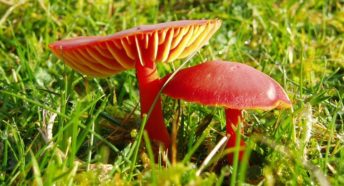A month in the countryside: connecting with nature in July
In her latest exclusive monthly column for CPRE, Susie White gives us her tips on what to look out for in nature – celebrating what makes the North Pennines so special, as well as the everyday beauty that can inspire us all.
Midsummer is when the sounds of nature change. Birds sing less often but we hear the voices of many insects, from the drone of bees to the stridulations of grasshoppers.
It’s the time of grassland butterflies and seed-laden grasses waving in the wind. Parties of noisy swifts fly screaming in circles and bats come out to forage on moths and midges. Children plodge in streams or play Pooh sticks from bridges.
The heat brings out common lizards to bask in the sun and I can work in my garden til late, enjoying the longer evenings.
Five ways to connect with nature this July
1. Watch moths like hawks
I’m now halfway through the season of light-trapping once a week for the Garden Moth Scheme (see my March blog). Different species of moths emerge at different times of the year; July includes some of the most spectacular. Because of their plump bodies, the hawk-moths take time to vibrate their wings before taking off and they will sit on my hand, perfect for showing off these spectacular insects to children.
Poplar hawk-moths, Laothoe populi, have dramatically sculpted grey wings. When feeling threatened they flash a red patch from their normally hidden hindwings. Elephant hawk-moths, Deilephila elpenor, are a confection of pink and lime-green. Their caterpillars are rumpled and grey like the trunk of an elephant. It’s for these caterpillars that I grow rosebay willowherb in my garden – though in the more unusual white form.

2. Marvel in a meadow
Midsummer is when the meadows of the North Pennines are ripening, when the semi-parasitic hay rattle is going to seed and the shaking of its pods is like tiny maracas. It’s an essential part of the ecology of these old meadows, reducing the fertility of the grasses so that wildflowers can thrive. This area has 40% of remaining UK upland hay meadows, the traditional management meaning that cutting is at the end of July or into August.

I have made my own mini-meadow using many of the same plants: hay rattle, melancholy thistle, red campion, ragged robin and birds foot trefoil. A delightful surprise was finding a common spotted orchid in an area that had once been a lawn.

3. Notice the woodwork of wasps
Sitting on a wooden bench I hear a quiet rasping sound. It’s a wasp and it’s stripping away the fine surface fibres to collect material for nest building. As it chews, it edges backwards, taking off the top silvery layer of wood to leave a line of brown revealed wood. Our bench is streaked with them in mottled patterns, a history of the activity of wasps.

When I’ve found abandoned wasps nests, hanging from the branch of the pear tree or attached to an overhang in a dry stone wall, I’ve kept these beautiful structures. They are papier-mache globes of varying shades of wood from different sources, their overlapping fibres woven together like felt.

4. Salute the garden all-rounder
Many people plant their gardens with pollinators in mind but it’s not just day-flying insects that need food. Many of the plants in my garden are there for moths as well. Adult elephant hawk-moths feed at night from tubular flowers such as honeysuckle.
A good all-round plant for a wildlife garden, honeysuckle provides nest sites for birds; aphids that are eaten by blue tits and ladybirds; berries for birds and mammals; as well as nectar-rich flowers. Honeysuckle grows wild in my nearby woods where it has a cool root run in the leaf litter before scrambling up trees towards the light. Plant it in the garden and the evening air is scented by its spicy sweet flowers.

5. Spot the difference in butterflies
Grasslands and parks are a good place to spot the brown butterflies – ringlet and meadow brown. They are more subtle in their colouring than the red admirals and peacocks of gardens. Ringlet, Aphantopus hyperantus, has grey-brown wings with a pattern of small dark circles with tiny white dots in their centres. They can be quite variable and are most defined on the underwings. Look for them amongst bramble flowers or bobbing about above damp grasslands.

Meadow brown, Maniola jurtina, is warmer in colouring with faded orange patches on its forewings and just one eyespot. When it rests on a stem with its wings closed there are no spots, an easy way to distinguish it from Ringlet.
Susie White is a writer and naturalist who lives and gardens in a small valley in the North Pennines Area of Outstanding Natural Beauty. Its diverse mix of habitats and landscapes provides a rich variety of wildlife to observe and record – including through her regular Country Diary entries for The Guardian.
Read more of Susie’s observations and enjoy her great photos on twitter @cottagegardener and remember to look out for her next CPRE column in August.









